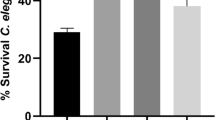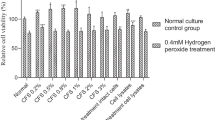Abstract
Lactobacilli and bifidobacteria are the most common genera of probiotics with documented potentials on gut health. Recent studies have suggested that such potentials can be extended beyond gut well-being, such as that of dermal health. Our present study aimed to evaluate the production of bioactives that are essential for skin defense, such as lipoteichoic acid, peptidoglycan, hyaluronic acid, sphingomyelinase, lactic acid, acetic acid, and diacetyl, from lactobacilli and bifidobacteria grown in milk. All strains studied showed the presence of LTA in the cell wall fraction, with higher amounts from Lactobacillus rhamnosus FTDC 8313 and Bifidobacterium longum BL 8643 than other strains studied. Meanwhile, all strains studied showed equal concentrations of cell wall peptidoglycan. Our results showed that all strains studied were capable of producing hyaluronic acid, with higher production by lactobacilli than bifidobacteria. Production of diacetyl was more prevalent from strains of lactobacilli, while bifidobacteria produced higher amounts of acetic acid. Strains of lactobacilli and bifidobacteria studied also produced acid and neutral sphingomyelinase, an enzyme that generates ceramides and subsequent development of physical barriers in the stratum corneum. Our current findings show that bioactive and inhibitive extracts are produced from the fermentation of lactobacilli and bifidobacteria in milk, with potentials for dermal applications.
Similar content being viewed by others
References
Carvalho ALU, Oliveira FHPC, Lima Ramos Mariano R, Gouveia ER, Souto-Maior AM (2010) Growth, sporulation and production of bioactive compounds by Bacillus subtilis R14. Braz Arch Biol Technol 53:643–652. doi:10.1590/S1516-89132010000300020
Chong BF, Blank LM, Mclaughlin R, Nielsen LK (2005) Microbial hyaluronic acid production. Appl Microbiol Biotechnol 66:341–351. doi:10.1007/s00253-004-1774-4
Christensen MD, Pederson CS (1958) Factors affecting diacetyl production by lactic acid bacteria. Appl Microbiol 6:319–322
Cooney MJ, Goh LT, Lee PL, Johns MR (2008) Structured model-based analysis and control of the hyaluronic acid fermentation by Streptococcus zooepidemicus: physiological implications of glucose and complex-nitrogen-limited growth. Biotechnol Progr 15:898–910. doi:10.1021/bp990078n
Di Marzio L, Cinque B, De Simone C, Cifone MG (1999) Effect of the lactic acid bacterium Streptococcus thermophilus on ceramide levels in human keratinocytes in vitro and stratum corneum in vivo. J Investig Dermatol 113:98–106. doi:10.1046/j.1523-1747.1999.00633.x
Fedtke I, Mader D, Kohler T, Moll H, Nicholson G, Biswas R, Henseler K, Gotz F, Zahringer U, Peschel A (2007) A Staphylococcus aureus ypfP mutant with strongly reduced lipoteichoic acid (LTA) content: LTA governs bacterial surface properties and autolysin activity. Mol Microbiol 65:1078–1091
Jang KS, Baik JE, Han SH, Chung DK, Kim BG (2011) Multispectrometric analyses of lipoteichoic acids isolated from Lactobacillus plantarum. Biochem Biophys Res Comm 407:823–830. doi:10.1016/j.bbrc.2011.03.107
Jensen JM, Forl M, Winoto-Morbach S, Seite S, Schunck M, Proksch E, Schutze S (2005) Acid and neutral sphingomyelinase, ceramide synthase, and acid ceramidase activities in cutaneous aging. Exp Dermatol 14:609–618. doi:10.1111/j.0906-6705.2005.00342.x
Kobayashi H, Terao T (1997) Hyaluronic acid-specific regulation of cytokines by human uterine fibroblasts. Am J Physiol Cell Physiol 273:C1151–C1159
Koncept Analytics (2010) Global probiotics market: trends and opportunities. Ireland: Research and Markets. http://www.researchandmarkets.com/research/2e0e00/global_probiotics. Accessed 21 July 2010
Lanciotti R, Patrignani F, Bagnolini F, Guerzoni ME, Gardini F (2003) Evaluation of diacetyl antimicrobial activity against Escherichia coli, Listeria monocytogenes and Staphylococcus aureus. Food Microbiol 20:537–543. doi:10.1016/S0740-0020(02)00159-4
Landis SJ (2008) Chronic wound infection and antimicrobial use. Adv Skin Wound Care 21:531–540. doi:10.1097/01.ASW.0000323578.87700.a5
Litzinger S, Duckworth A, Nitzsche K, Risinger C, Wittmann V, Mayer C (2010) Muropeptide rescue in Bacillus subtilis involves sequential hydrolysis by β-N-acetylglucosaminidase and N-acetylmuramyl-L-alanine amidase. J Bateriol 192:3132–3143. doi:10.1128/JB.01256-09
Machado MC, López CS, Heras H, Rivas EA (2004) Osmotic response in Lactobacillus casei ATCC 393: biochemical and biophysical characteristics of membrane. Arch Biochem Biophys 422:61–70. doi:10.1016/j.abb.2003.11.001
Magni C, de Mendoza D, Konings WN, Lolkema JS (1999) Mechanism of citrate metabolism in Lactococcus lactis: resistance against lactate toxicity at low pH. J Bacteriol 181:1451–1457
Matsubara C, Kajiwara M, Akasaka H, Haze S (1991) Carbon-13 nuclear magnetic resonance studies on the biosynthesis of hyaluronic acid. Chem Pharm Bull 39:2446–2448
Nagoba B, Wadher B, Kulkarni P, Kolhe S (2008) Acetic acid treatment of pseudomonal wound infections. Eur J Gen Med 5:104–106. http://www.bioline.org.br/request?gm08019. Accessed 9 March 2012
Nell MJ, Tjabringa GS, Vonk MJ, Hiemstra PS, Grote JJ (2004) Bacterial products increase expression of the human cathelicidin hCAP-18/LL-37 in cultured human sinus epithelial cells. FEMS Immunol Med Microbiol 42:225–231. doi:10.1016/j.femsim.2004.05.013
Niebuhr M, Baumert K, Werfel T (2010) TLR-2-mediated cytokine and chemokine secretion in human keratinocytes. Exp Dermatol 19:873–877. doi:10.1111/j.1600-0625.2010.01140.x
Østlie HM, Helland MH, Narvhu JA (2003) Growth and metabolism of selected strains of probiotic bacteria in milk. Int J Food Microbiol 87:17–27. doi:10.1016/S0168-1605(03)00044-8
Palframan RJ, Gibson GR, Rastall RA (2003) Carbohydrate preferences of bifidobacterium species isolated from the human gut. Curr Iss Intest Microbiol 4:71–75
Parche S, Beleut M, Rezzonico E, Jacobs D, Arigoni F, Titgemeyer F, Jankovic I (2006) Lactose-over-glucose preference in Bifidobacterium longum NCC2705:glcP, encoding a glucose transporter, is subject to lactose repression. J Bacteriol 188:1260–1265. doi:10.1128/JB.188.4.1260-1265.2006
Pasricha A, Bhalla P, Sharma KB (1979) Evaluation of lactic acid as an antibacterial agent. Indian J Dermatol Venereal Leprol 45:159–161. http://www.ijdvl.com/article.asp?issn=0378-6323;year=1979;volume=45;issue=2;spage=149;epage=161;aulast=Pasricha;type=0. Accessed 11 March 2012
Price RD, Berry MG, Navsaria HA (2007) Hyaluronic acid: the scientific and clinical evidence. J Plast Reconstr Aesthetic Surg 60:1110–1119. doi:10.1016/j.bjps.2007.03.005
Quintans NG, Blancato V, Repizo G, Magni C, López P (2008) Citrate metabolism and aroma compound production in lactic acid bacteria. In: Mayo B, López P, Pérez-Martínez G (eds) Molecular aspects of lactic acid bacteria for traditional and new applications. Research Signpost, Kerala, pp 65–88
Rawlings AV, Davies A, Carlomusto M, Pillai S, Zhang K, Verdeio P, Feinberg C, Nguyen L, Chandar P (1996) Effect of lactic acid isomers on keratinocyte ceramide synthesis, stratum corneum lipid levels and stratum corneum barrier function. Arch Dermatol Res 288:383–390. doi:10.1007/BF02507107
Reith J, Berking A, Mayer C (2011) Characterization of an N-acetylmuramic acid/N-acetylglucosamine kinase of Clostridium acetobutylicum. J Bacteriol 193:5386–5392. doi:10.1128/JB.05514-11
Sullivan M, Schnittger SF, Mammone T, Goyarts EC (2009) Skin treatment method with lactobacillus extract. US Patent 7,510,734 B2, 31 March 2009
Suskovic J, Kos B, Beganovic J, Pavunc AL, Habjanic K, Matosic S (2010) Antimicrobial activity- The most important property of probiotic and starter lactic acid bacteria. Food Technol Biotechnol 48:296–307
Tham CSC, Peh KK, Bhat R, Liong MT (2011) Probiotic properties of bifidobacteria and lactobacilli isolated from local dairy products. Ann Microb. doi:10.1007/s13213-011-0349-8
Vandergh PA (1993) Lactic acid bacteria, their metabolic products and interference with microbial growth. FEMS Microbiol Rev 12:221–238. doi:10.1111/j.1574-6976.1993.tb00020.x
van Langevelde P, van Dissel JT, Ravensbergen E, Appelmelk BJ, Schrijver IA, Groeneveld PHP (1998) Antibiotic-induced release of lipoteichoic acid and peptidoglycan from Staphylococcus aureus: quantitative measurements and biological reactivities. Antimicrob Agents Chemother 42:3073–3078
Wang Z, MacLeod DT, Di Nardo A (2012) Commensal bacteria lipoteichoic acid increases skin mast cell antimicrobial activity against vaccinia viruses. J Immunol. doi:10.4049/jimmunol.1200471
Yang S, Tamai R, Akashi S, Takeuchi O, Akira S, Sugawara S, Takada H (2001) Synergistic effect of muramyldipeptide with lipopolysaccharide or lipoteichoic acid to induce inflammatory cytokines in human monocytic cells in culture. Infect Immun 69:2045–2053. doi:10.1128/IAI.69.4.2045-2053.2001
Acknowledgements
This work was supported by the FRGS grant (203/PTEKIND/6711239) provided by Ministry of Higher Education, Malaysia and USM Fellowship provided by Universiti Sains Malaysia.
Author information
Authors and Affiliations
Corresponding author
Rights and permissions
About this article
Cite this article
Lew, LC., Gan, CY. & Liong, MT. Dermal bioactives from lactobacilli and bifidobacteria. Ann Microbiol 63, 1047–1055 (2013). https://doi.org/10.1007/s13213-012-0561-1
Received:
Accepted:
Published:
Issue Date:
DOI: https://doi.org/10.1007/s13213-012-0561-1




